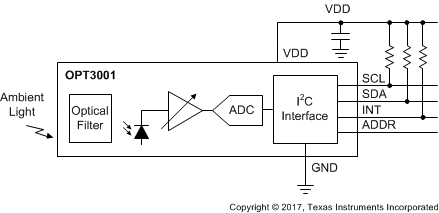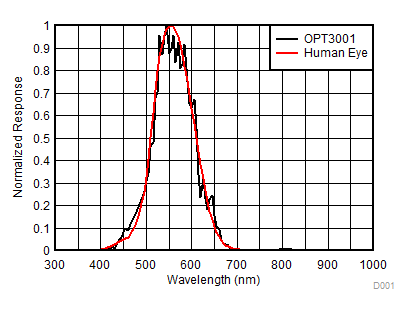SBOS853A March 2017 – December 2018 OPT3001-Q1
PRODUCTION DATA.
- 1 Features
- 2 Applications
- 3 Description
- 4 Revision History
- 5 Description (continued)
- 6 Pin Configuration and Functions
- 7 Specifications
-
8 Detailed Description
- 8.1 Overview
- 8.2 Functional Block Diagram
- 8.3 Feature Description
- 8.4 Device Functional Modes
- 8.5 Programming
- 8.6
Register Maps
- 8.6.1
Internal Registers
- 8.6.1.1
Register Descriptions
- 8.6.1.1.1 Result Register (offset = 00h)
- 8.6.1.1.2 Configuration Register (offset = 01h) [reset = C810h]
- 8.6.1.1.3 Low-Limit Register (offset = 02h) [reset = C0000h]
- 8.6.1.1.4 High-Limit Register (offset = 03h) [reset = BFFFh]
- 8.6.1.1.5 Manufacturer ID Register (offset = 7Eh) [reset = 5449h]
- 8.6.1.1.6 Device ID Register (offset = 7Fh) [reset = 3001h]
- 8.6.1.1
Register Descriptions
- 8.6.1
Internal Registers
- 9 Application and Implementation
- 10Power Supply Recommendations
- 11Layout
- 12Device and Documentation Support
- 13Mechanical, Packaging, and Orderable Information
Package Options
Mechanical Data (Package|Pins)
- DNP|6
Thermal pad, mechanical data (Package|Pins)
Orderable Information
3 Description
The OPT3001-Q1 device is an optical sensor that measures the intensity of visible light. The spectral response of the sensor tightly matches the photopic response of the human eye and includes significant infrared rejection.
The OPT3001-Q1 device is a single-chip lux meter, measuring the intensity of light as visible by the human eye. The precision spectral response and strong IR rejection of the device enables the OPT3001-Q1 device to accurately meter the intensity of light as seen by the human eye, regardless of light source. The strong IR rejection also aids in maintaining high accuracy when industrial design calls for mounting the sensor under dark glass for aesthetics. The OPT3001-Q1 device is designed for systems that create light-based experiences for humans, and an ideal preferred replacement for photodiodes, photoresistors, or other ambient light sensors with less human eye matching and IR rejection.
Device Information(1)
| PART NUMBER | PACKAGE | BODY SIZE (NOM) |
|---|---|---|
| OPT3001-Q1 | USON (6) | 2.00 mm × 2.00 mm |
- For all available packages, see the package option addendum at the end of the data sheet.
Block Diagram

Spectral Response: OPT3001-Q1 and the Human Eye
